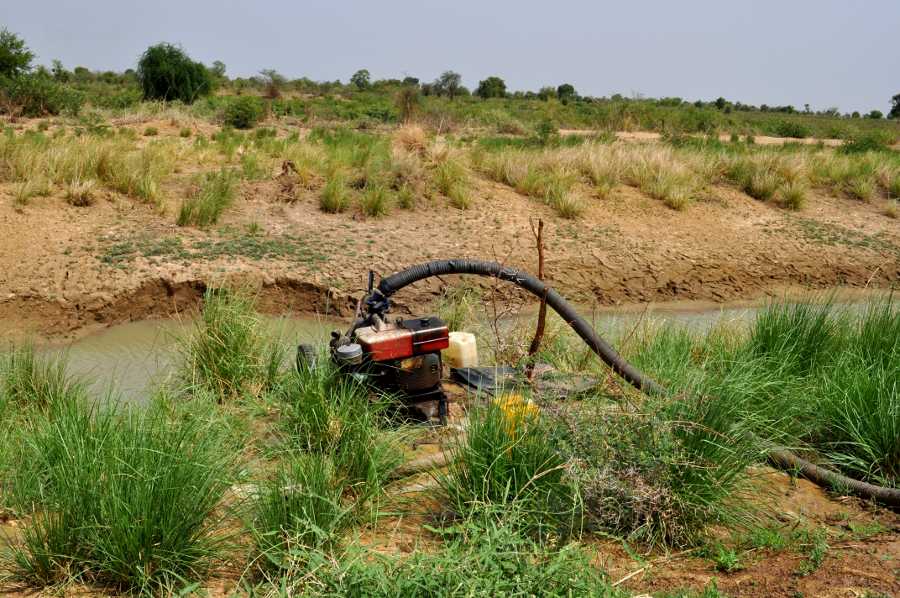Producers in the Sourou valley deprived of water, now
redirected to MCA-BF development projects,
On June 7th I went up to Niassan in the Sourou valley, invited by Mr Valentin Bitié, President of the Union of Farmers’ Cooperatives in Sourou ( Union des cooperatives Agricoles du Sourou, UCAVASO). He wanted to show me the state of the rice paddies in ”his valley”, the Sourou river basin, in particular around the villages of Niassan and Débé. I was shocked to discover a scene of desolation. A great many fields had been hit by drought. Cattle roamed around freely on the plots that had initially been under irrigation, but were the grass was already dry. These fields had not yielded any rice, just a bit of grass for the animals.
How come that there is now a drought, while the Sourou river valley had abundant water at Christmas?
There had been no signs of the forthcoming disaster. The President of Burkina, Blaise Compaoré, had actually launched the start of vast irrigation projects around the village of Di on December 17th before an enthusiastic crowd, as part of the government programme for the “Development of Agriculture”. Di had been selected as the site for the “Water and Agriculture” section of the programme, under the Millennium Challenge Account-Burkina Faso (MCA-BF) , financed by the US Millennium Challenge Corporation MCC. Its objective is the development of 2033 hectares* of irrigated land around the municipality of Di.

 But suddenly, in mid-January, farmers in the Sourou valley noticed that the water level in the river was falling more quickly than it used to. Going to check at the Lery dam (which retains the water stopping it from escaping into the Mouhoun river), they realised that the gates were letting through a heavy flow of dam water. Worried they alerted the Sourou Valley Development Authority (AMVS).
But suddenly, in mid-January, farmers in the Sourou valley noticed that the water level in the river was falling more quickly than it used to. Going to check at the Lery dam (which retains the water stopping it from escaping into the Mouhoun river), they realised that the gates were letting through a heavy flow of dam water. Worried they alerted the Sourou Valley Development Authority (AMVS).
The AMVS reassured the farmers, telling them there was nothing to worry about and that they should carry on with their work (growing Bondofa maize and rice). They therefore started their usual “dry season” tasks (the subsequent irrigation being provided exclusively by water from the Sourou river) preparing the soil, sowing, planting the shoots … and spending important sums on fertilizer and fuel for the water pumps.
On April 28th the situation was already dramatic. The president of UCAVASO therefore called a meeting of all the cooperatives, with just one item on the agenda: The lack of water in the normally irrigated areas. During the discussion it emerged that some pumping stations no longer were able to bring forth the water needed for the fields under cultivation.
The question arises: What will become of the farmers in the Sourou Valley during a season with no water supply?
The cooperatives of CANI (cooperatives of Niassan) totalling 500 hectares and CAD of Débé with 475 hectares appear to be the hardest hit, because the water has simply vanished below the cylinders which propel the water out from the pumping station into the field. Most of the maize fields have already wilted, the others will follow within a week.
During the meeting of April 28th the recommendation was made to carry out an inventory of the fields under cultivation of each cooperative and the size of the devastated areas. At my visit to Niassan the following results were produced:
CANI, the cooperatives of Niassan, with a total of 500 hectares
179 ha of rice, of which 112 ha did not attain maturity because of the lack of water
– Bofonda maize 84 hectares, of which 40 had dried up
CAD, the cooperatives of Débé (475 hectares)
- 225 hectares of rice, of which 175 hectares were burnt out
- 174 hectares of Bofonda maize of which 75 hectares were burnt out
One can easily work out the losses which each of the cooperatives have suffered. We made a quick calculation on the following basis: Usual yield of the rice paddies: 5.5 tons/hectare (the rate generally applied by the SONAGESS); yield of maize: 3 tons/hectare. Selling price for paddy rice: 175 000 CFA francs a ton. Selling price for maize: 120 000 francs a ton.
This amounts to losses of
- 122 200 000 francs by CANI and
- 195 437 500 francs by CAD
or a total of 317 637 500 francs for both, a considerable sum of money, apart from the fact that they are not the only ones having lost due to the shortage of water.

 Who will pay the bill? PPerhaps the Millennium Challenge Account-Burkina Faso (MCA-BF), which caused the shortage. After all it has a budget of 64 billion francs. It would be unfair to charge the loss on the valley farmers, who had not even been informed that work undertaken by the MCA-BF would result in a substantial reduction of water levels in the valley.
Who will pay the bill? PPerhaps the Millennium Challenge Account-Burkina Faso (MCA-BF), which caused the shortage. After all it has a budget of 64 billion francs. It would be unfair to charge the loss on the valley farmers, who had not even been informed that work undertaken by the MCA-BF would result in a substantial reduction of water levels in the valley.
At the beginning of June two water gates were still open at the Léry dam and the construction work for the development of the 2033 hectares continues as if the lack of water for the farmers were not a problem. But for them the situation is indeed disastrous. They still do not understand why they could not have been warned in time. They are now investigating their losses in order to submit the bill to the AMVS demanding compensation (from the MCA-BF?)
That would only be fair!
Niassan, June 7th 2012 July
Maurice Oudet
Director, SEDELAN









